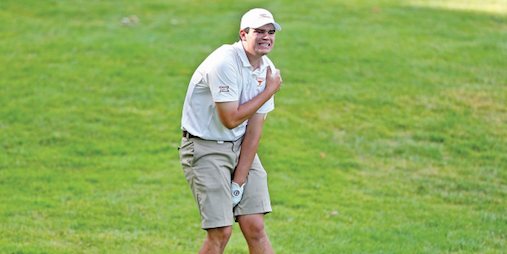
Beau Hossler's injury at the 2016 NCAA Championship
sparked the debate
(Golfweek Photo)
LAS VEGAS, NV (December 17, 2016) -- The story coming out of this year’s Golf Coaches Association of America National Convention was that there really wasn’t a story.
This year was no different than past gatherings of coaches in that there are always topics on the front burner. However, there seemed to be no traction or consensus among the coaching body on any one issue.
The most-discussed topic was the substitution rule. In early October, the NCAA Division I Competition Oversight Committee met in Indianapolis to discuss enhancements in several NCAA sports, including men’s and women’s golf. Among the tabled discussions was one involving a proposal that would allow substitutions in the NCAA Division I Men’s Golf Championships. Many expected this to pass for at least the championship or part of. However, walking the hallways at the Planet Hollywood Resort and Casino, coaches are all over the board on this one.
There is a group of coaches who would like to see the substitution rule in place for the entire season. Others are in favor of it for the postseason or even match-play portion only. Most discussions found a path to this topic, and it led to many questions and concerns.
It seemed like the majority was in favor of the idea of substitutions, however too many questions kept many from a seal of approval. How to deal with individual rankings and the extra cost were the biggest factors.
However, like many other changes we have seen in college golf there would certainly be unforeseen issues in the future with a change of this significance.
Georgia Tech head coach Bruce Heppler may have said it best, as he often does: “We are trying to do two things at once and it simply does not work.”
Heppler’s comment was in reference to hosting an individual championship and team championship at the same time. One thought, which has been discussed in the past, is to have the fall season be geared toward individual play with a championship in November. The spring season, then, would be all about the team and a team championship in the normal time slot.
College golf has been manufactured into a team game and in my opinion, allowing substitutions all year long would fit with the direction of college golf. However, this will be a hard topic for which to nail down specifics.
The more pressing issue, as I see it, is the need for a standardization of formats in college golf. This was discussed briefly. There are too many formats used. Five-count-four (the most popular), six-count-five and match play. All of these are different and can have an advantage or disadvantage to a particular team. Length of tournaments vary as well – from 18 holes to 72 holes.
The most popular solution to this is to standardize play for a certain number of a team’s 24 playing dates. The remaining competition days would be exempt from rankings and could be used for any format desired. Most felt six exempt days would be sufficient.
Another topic that garnered discussion was the placement of postseason teams. Rather than using the S-curve to seed the field, there was talk of allowing the teams (in order of ranking) to select where they would like to go. A very unique idea, but again would require much thought on if and how this could work.
On the women’s side, the substitution rule was also discussed, but the biggest news this fall was that the oversight committee did not approve the adoption of the .500 rule, which requires teams have a .500 record or better against Division I opponents to be considered for an at-large selection to an NCAA regional.
This was a head-turner. The men have had this rule in place for a decade and it has had a positive impact, according to most.
The comment in the October report regarding the .500 rule seemed a bit out of touch with what the rule has provided the men’s game.
“Oversight committee members were concerned the change could negatively impact scheduling by potentially weakening, rather than strengthening, tournament fields and in turn hinder the sport rather than promote its growth,” the report stated.
Most on the men’s side would say in regards to promoting the growth of the game, it has been a plus.
While there was no discussion of a women’s .500 rule in the general session, there is going to be another push from the quiet majority who want this in play.
Most would agree the convention was a huge success and the merger of the men’s and women’s coaching bodies in many segments is a positive move. The convention is scheduled to return to Las Vegas in 2017.
Editors Note: Story by Lance Ringler of Golfweek